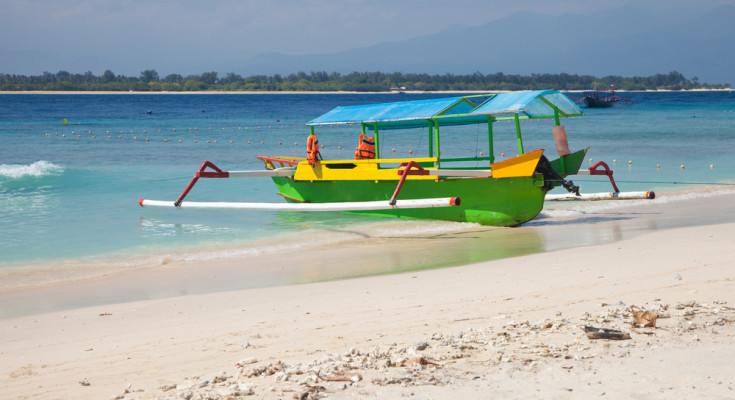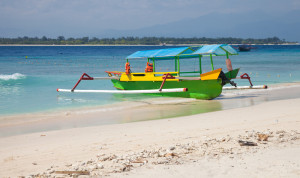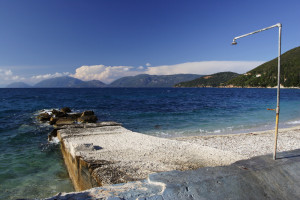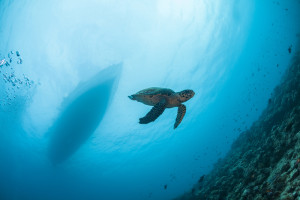By: Laura Noszlopy
I visited Gili Air again last Ramadan, inspired by a previous trip in April. I hadn’t meant to stay away so long. Despite the acute paradise fantasies of many of my friends back home—who imagine that I spend my life lazing on a sun-soaked beach, gazing at the pristine turquoise ocean from under the gentle swaying palms, while sipping on a ridiculously glamorous cocktail—my everyday life in Bali bears little resemblance to this vision. So, when I have a holiday, I go to Gili Air. This way, I can properly indulge their paradise fantasies (and mine). With the offices closed for the Idul Fitri holidays, my friend Patrizia and I decided to join the exodus and take a break too.
Our journey from Denpasar started early: we checked in for the first Merpati flight to Mataram, Lombok at 6am. We took off within an hour in a small propeller plane and landed twenty-five minutes later after a smooth flight over the seaweed farms of Nusa Lembongan.
At the aiport, we caught a pre-paid, air-conditioned taxi to begin the breathtaking drive through the hills to the harbour town of Bangsal, the somewhat notorious departure point for Gili Air and her sister islands—which are collectively called Gili Indah, ‘Beautiful Islands’ (though they are known amongst travellers simply as ‘The Gilis’). Despite still being a week away from the onset of the rainy season, the landscape was outrageously green. There are notably fewer houses and less people around than in the Balinese countryside. When we arrived at the harbour, the so-called ‘Bangsal mafia’ were up and about. The taxi stopped, or was stopped, at the gates, apparently in the hope that we would hire a cidomo (horse cart) to carry us the fifty dusty metres to the boats. We walked there.
Expensive
Our arrival so early in the day drew quite a crowd (out-going tourists on their way back to the mainland constitute the bulk of the morning traffic). We were warned emphatically by the locals that everything would be “much more expensive in Gili Air” and that we should stock up on (very expensive) cigarettes and bottled water at the shops around the harbour. Almost every consumable, with the exception of coconuts and fish, needs to be imported from the mainland (though it’s not much more expensive, by the way).
The hard-sell continued as we were urged to charter a whole boat to carry us to our final destination. Having smiled and graciously ignored most of this heckling, we purchased some provisions and headed to the official koperasi (co-operative) ticket office at the waterfront. We waited a few minutes, while someone in the office screamed wildly through the loudspeakers about needing another three people to justify the boat’s departure, but soon made the twenty minute journey in the comfortable and seaworthy public shuttle.
Candlelight
Several cidomo wait around the arrival area on Gili Air, ready to carry guests and baggage to wherever they need to go. This hasn’t changed much since the first tourists started to arrive in the late 1970s, and neither has the atmosphere of simple seaside living. By 1980, there were a few simple accommodations to cater to the growing tourism industry and in 1993 all three islands were declared a ‘Marine Recreation Park’ by the Indonesian Ministry of Forestry.
“It was only in 1997 that candlelight and generators were replaced by mains electricity.”
One of the other truly appealing features of the three Gili Indah is the complete lack of motorised vehicles on land; people use cidomo, pushbikes or their feet to get around. We arrived at our hotel in time for breakfast at the beach and then checked into our hotel to take a shower. The shower made me laugh: the water that came out of the faucet was salty. Naturally, I put this down to our being on a small, sea-bound island at the end of the dry season, but then it occurred to me: how ironic that this place is called ‘Water Island’ (Gili means ‘island’, and Air is Indonesian for ‘water’) and we end up rinsing our faces in bottled water.
Issue of salty water
According to Din, an old friend of Patrizia’s from the pre-electricity days, the issue of salty water has been a local concern for years. He invited us to use the shower at his house in the kampung (residential quarter). The kampung on Gili Air—which, because it is the only one, doesn’t have a special name—with its homes, primary school and mosque, is tucked into the centre of island, well hidden from the beach strip and easy for tourists to miss. It’s an attractive place, with houses constructed in wood, concrete and rattan, spaced loosely among the palms and grazing cows. Din let us in on another irony: there are indeed freshwater sources on the island—many of the homes in the kampung have their own wells —but they’re all inland, away from the beach and tourist accommodation. While almost everyone born here (last population count: 1460) is linked to the tourism economy in some way, there’s currently no way to ensure that the locus of the industry has easy access to this basic necessity.
Everyday life is centred on the comings and goings at the harbour. There is no central market here and people buy their provisions as they are unpacked from the incoming boats, from small shops or—after 11am—from women bearing their wares on their heads, having brought them back from Mataram earlier in the morning. Like the foodstuffs, household goods and raw materials for the tourist industry (such as bottles of suntan lotion and ingredients for pizza and salads), much of Gili Air’s water is brought from the mainland. The water is subsidised by the provincial government of West Lombok and managed by the National Regional Drinking Water Company or PDAM (Perusuahaan Daerah Air Minum Negara). It is regularly brought to the island to be dispensed to the people.
Din’s older brother, Pak Karim, who owns a small fleet of three water-carrying boats, explained the logistics of providing the island with a steady source of freshwater. He said that each vessel can carry up to 3000 litres of water in its large, blue plastic tank: “If it’s busy, we can make up to five trips a day (split among all three islands), but we average three trips a day.” Karim explained that the water is brought all the way from Selelos, a town at the foot of Mount Rinjani. From this source, it is piped all the way across Lombok to Bangsal harbour, where it is loaded onto the boats. When it reaches the shore, the water is piped into smaller containers. Naturally, the transportation costs raise the price of the water considerably: a 3000 litre cargo, which would sell in Bangsal for Rp 45.000, costs Rp 120.000 by the time it arrives in Gili Air.
The best way to spend it
When we visited the kepala dusun (community leader), Pak Kadus, who lives just a few doors away from Din, he told us of plans to implement a major new water project, funded by the provincial government, that should make life much easier for the islanders. From the water tower, larger quantities of water would be made more accessible by piping it directly to homes without their own reliable well: “We’re used to it [the water issue], but we had to use the money from the government. We asked what would be the best way (to spend it) and decided to make a water tower. The youngsters are always looking for the easy way—using a tap!” As well as making access and daily life easier for the population, this plan would also reduce the costs involved when buying water at the harbour. “We’re starting with the people of the kampung,” said Pak Kadus, “after that, it will spread to the hotels.”
In general, though, the population seems somewhat divided on the water issue. Many of those born into the kampung community have, of course, adjusted to the water’s natural salinity and still cook with it, while others complain that they think it might have adverse effects on their health. Laughing raucously, Ibu Mora, one of the vendors who works on the beach, said she actually quite likes the resulting saltiness of the food, “especially if you don’t mind eating a lot of cucumber with your dinner—to wash the mouth.” The relatively large number of migrant workers from Lombok and beyond—who dominate the tourism workforce—tend to use the imported water instead when they’re cooking. Even so, Ema, the wife of a hotel worker from Central Lombok, complained that the local water renders her family’s laundry strangely stiff: “It dries in the same shape as you hang it out,” she explained, “and it makes my hair brittle like rice stalks.”
Quite delicious
On the other hand, salty water, in its proper place, is quite delicious. After school, the local children run down to the beach to play, swim and snorkel. The major successes of tourism here are also bound up with the aquatic side of life. The beaches are as they are in postcards; as pristine as I’ve seen in Indonesia. Several dive centres have been established here in the past twenty years and are doing well. Local fishermen and boatmen also make a living taking visitors out on snorkelling and fishing trips. For those less comfortable with the deep, excursions on a glass-bottomed boat are available; the coral, multi-coloured fish, and even the turtles are visible without even getting one’s toes wet. In the evenings, beside this stretch of gorgeously clean, salty water, visitors can enjoy grilled seafood suppers on the beach, seated atop open wooden pavilions strewn with cushions. Hordes of very handsome, healthy cats—who often frequent the fish restaurants of an evening—wander around nonchalantly, casting charming smiles towards the fishy leftovers.
On Gili Air, with its heavy reliance on revenue from eco- and aqua-tourism, environmental awareness seemed to be much higher than in other places I have visited in the archipelago. Community projects like the regular clean-ups of the beach, legislated changes in fishing styles, and the fitting of several permanent buoys in the reef area to avoid the need to throw anchors down on top of the coral, seem to have been largely successful and the guys we spoke to on the beach were eager to discuss environmental issues. The practice of ‘fish bombing’— the use of dynamite to kill large numbers of fish, while also destroying the coral reef—was outlawed here ten years ago and regular patrols by the local Asosiasi (association) have been executed for the past five. According to Pak Kadus, this legislation is also enforced by the community: “There are social sanctions,” he said, “If we knew someone had been fishing like that, we would talk to them or maybe the people wouldn’t attend weddings in that family, for example. So eventually it stopped.”
There are several shops and establishments on the island where used plastic water bottles can be re-filled for just Rp 2000; which works out well for everyone. Education and public awareness sessions for both locals and visitors are key, with regular anti-littering campaigns and the abundant posting of notice boards bearing ecologically sensible slogans like ‘conserve our water—use less’; ‘don’t stand on the coral’; and ‘please don’t touch the turtles’. Reefseekers, one of the dive centres, established in 1985, runs a turtle nursery where eggs can be laid in safety and get a better start in life. Baby turtles face threats from predators such as dogs and lizards on their journey from the hatching site to the water, and are at risk of being eaten by a whole range of aquatic predators (not to mention their worst enemy: people) once they reach the sea. 707 have been released into the sea since the nursery opened. Sick or injured turtles can also find respite and medical care. Most of these are rescued from illegal smugglers shipping live animals from Sulawesi or Maluku to Bali, by a joint venture between environmentalists and the Indonesian navy.
Huge, decades-old turtle
Aside from one permanent resident called Fred, most of the rescue turtles are returned to the sea to re-establish their lives in the less perilous waters around the islands. Fred is a huge, decades-old green turtle who was missing one front flipper when he was caught. He lost the other when, after he was captured, his remaining flipper and his stump were tied so tightly together that both sides were amputated. He will never be able to live independently now. The nursery is funded by donations from visitors, so it’s part of the ecological-economic cycle of the island: tourists come because of the marine life and its protection depends, to a certain extent, on awareness raised through the maintenance of the tourist trade. The dive-masters at the centre are determined to promote ecologically sound, sustainable practices and raise their clients’ awareness of reef conservation. According to Catherine, a dive-master from England: “We give the divers a marine briefing every morning—about proper weighting and positioning to avoid hurting the coral. Many people just don’t know the basics. Like with the puffer-fish, for example: people like to poke them until they puff up, but they only do this naturally when they’re under attack. It’s like a heart attack, they can only tolerate one or two attacks in a lifetime or they die.”
Back on dry land
Although the marine life around the Gili Indah is still extensive and much of the reef is growing back, she said it’s imperative that the awareness raising campaigns and Asosiasi patrols continue. So, the salty water has both pros and cons. The sea here is the cleanest, most hospitable and tropical fish-full that I’ve ever seen. But showering in salty water wrecks your hair after a couple of days and, I imagine, cooking with it wrecks your health after a couple of years. For a short-term guest, though, it is no bother at all. And anyway, local community leaders are working hard to improve the situation. Back on dry land, you can walk around the whole island in an hour and a half. To my mind, the absence of cars and motorbikes alone qualifies Gili Air as an Indonesian ‘paradise’. As I boarded my return flight, I recalled lazing on a sun-soaked beach, gazing at the pristine turquoise ocean from under gently swaying palms, while sipping on a ridiculously glamorous cocktail. Why do I always stay away so long?
(First published in Latitudes Magazine)














